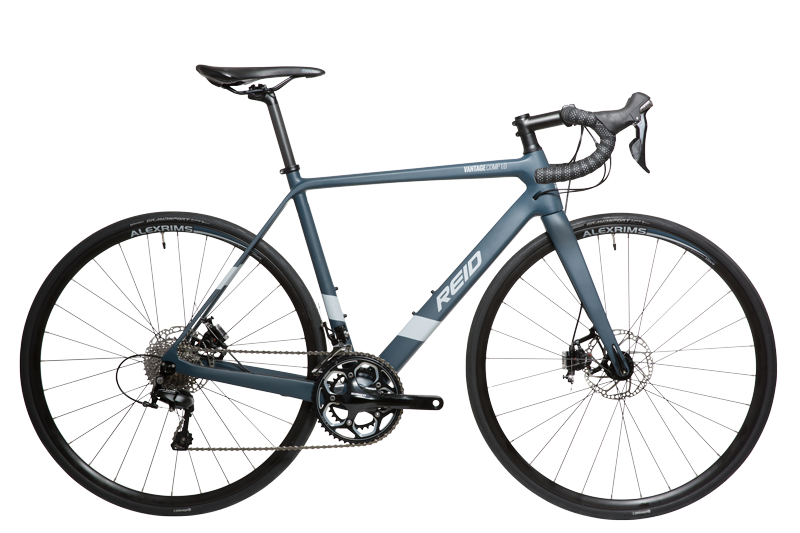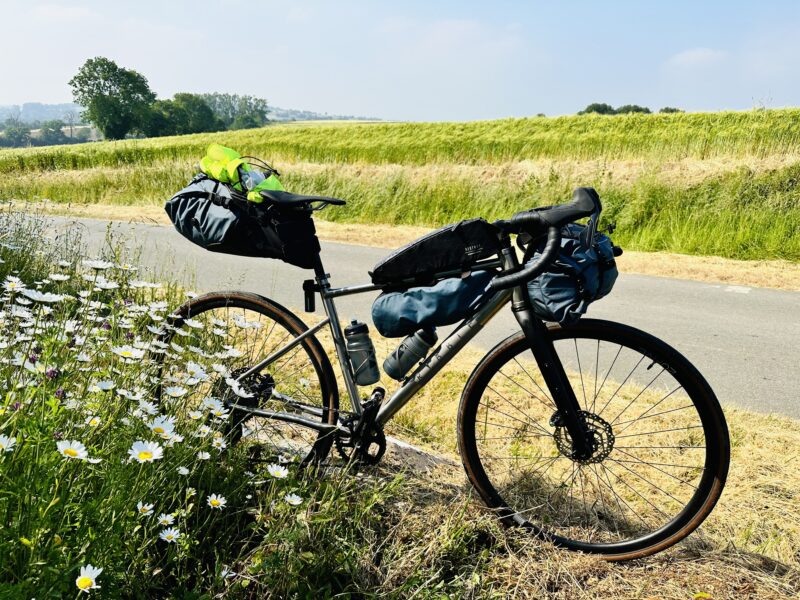Review: Reid Vantage Comp Carbon Race 1.0

Stu Moysey tries this carbon racer targeted at the budget savvy roadie who doesn’t want to compromise on performance.
Reid Cycles have undergone something of a renaissance over the past year, slowly shedding their perception as a budget brand with the release of well-received mountain- and road-bikes. Their road bikes have always been sharply priced, to the point that people used to buy them just to use the parts on a different frame, but the new Vantage series are a ground-up redesign based around disc brakes. That series has two aluminium models with endurance geometry, and a third – their first foray into carbon fibre – in a more aggressive format.
We were sent this model, the Vantage Comp Carbon Race 1.0, for review and to see whether it continued the brand’s positive trajectory.
The Vantage Comp Carbon Race 1.0 is based around a full carbon frame and fork, running a Shimano 105 5800 groupset, with stopping duties handled by TRP’s Hy/Rd disc brakes. Pricing comes in at $1,699 – somewhere around $500–$1,000 cheaper than equivalently specced competition. As a comparison, the Giant Defy 1 Disc retails at $1,799 with the same groupset, but an aluminium instead of carbon frame and the inferior TRP Spyre brakes. The Vantage, then, is very sharply priced indeed.
The geometry of this bike skews more to the lower, longer racing bike side of the spectrum rather than the endurance geometry that I am more accustomed to, and there was a period of adjustment for me which led to a certain stiffness through my upper back.
One of the most controversial points of road bike design over the past couple of years is the move to disc brakes, and I was eager to see whether there was any downside to this technology. The TRP Hy/Rd is an interesting design – rather than being a fully mechanical system, it’s a blend of mechanical and hydraulic, with a conventional road lever actuating a hydraulic chamber down at the caliper. It’s not the most elegant looking caliper but there are a couple of benefits to it. Firstly, it’s much cheaper than a full hydraulic system, whilst being less complex to work on for the home mechanic. And functionally it’s pretty great, offering the vast majority of the braking performance and feel of a hydraulic set-up without bulky hydraulic levers. I tested the Vantage through a wet Melbourne winter and had faultless, consistent braking power at all times, even in grim conditions.
The frame is equipped with through-axles front and rear instead of conventional quick release skewers, and ensured there was no unwanted rub on the disc rotors even when I leaned into corners and threw my weight around. In particular, when on steeper ascents, it meant that whenever I climbed out of the saddle, I didn’t lose any watts to a misaligned disc brake. Even though through-axles are a touch heavier, the pros outweigh the cons – plus, they make wheel realignment after transport much more consistent.
At 9.3kg, this bike is slightly heavier that many other road disc bikes on the market but it hides its weight well. Whilst the weight wasn’t a problem, I did feel it could be a little bit stiffer through the bottom bracket for my taste. When it came time to really put the power down on a quick sprint or straight section of the road there was a bit of flex and feedback that didn’t quite feel right.
The gearing range of the Vantage is more ‘all-day’ rather than ‘race-day’ – a slight contradiction to the geometry and aggressive stance of the bike, but I think a smart choice. It pairs a non-series Shimano compact crankset (50/34t) with an 11–32t cassette at the back, providing ample range for the steepest of steep pinches and giving the confidence to push myself harder for longer – it’s nice to know that you’ve got a bail-out gear there if you blow up on longer climbs and just need to sit there and grind it out.
The Vantage is reasonably comfortable, a fact that can be attributed to a few canny choices design-wise. Firstly, the move to disc brakes means that there’s no bridge between the seat-stays, granting extra compliance to their already slender construction. The bike also comes stock with supple 25mm Continental tyres, mounted on a 21mm (internal) rim width, allowing lower pressures and a touch more cush. Further, the frame can accommodate up to 28mm tyres.
The dialled back colour scheme is certainly a head turner and whenever I pulled up at lights or stopped at my local cafe there were plenty of compliments towards the matte navy and grey paintwork. The pictures really don’t do this colour scheme justice – it is full of subtle panache, turning heads without being flashy.
One thing to note is the potential for toe overlap on this bike. Admittedly, I do have stupidly large canoes for feet (US size 13), but even on the large frame, I still found myself clipping the front wheel from time to time due to the tight front end. Granted, I have massive clown feet, but it’s something to be mindful of.
Overall this bike is full of well-thought-out details that you wouldn’t normally see at this price range – internal cabling, through-axles and a full carbon setup (including seat post) are all welcome additions to this bike and a neat demonstration of Reid’s evolution.
Frame Carbon fibre
Fork Carbon fibre
Brakes TRP Hy/Rd Disc cable actuated hydraulic brakes (160mm rotors)
Gearing Shimano 105 2 x 11 Compact Gearing
Rims Alex ADT470 Double Wall Alloy Race
Hubs Novatec Sealed Bearing Thru Axle Hubs
Tyres Continental Grand Sport Race 700x25C
Weight 9.3kg for M/L
RRP $1,699
Function 32/40
Quality 32/40
Price 10/10
Appearance 9/10
Overall: 83%
Price $1,699
For more info and dealers www.reidcycles.com.au
Ride On content is editorially independent, but is supported financially by members of Bicycle Network. If you enjoy our articles and want to support the future publication of high-quality content, please consider helping out by becoming a member.







